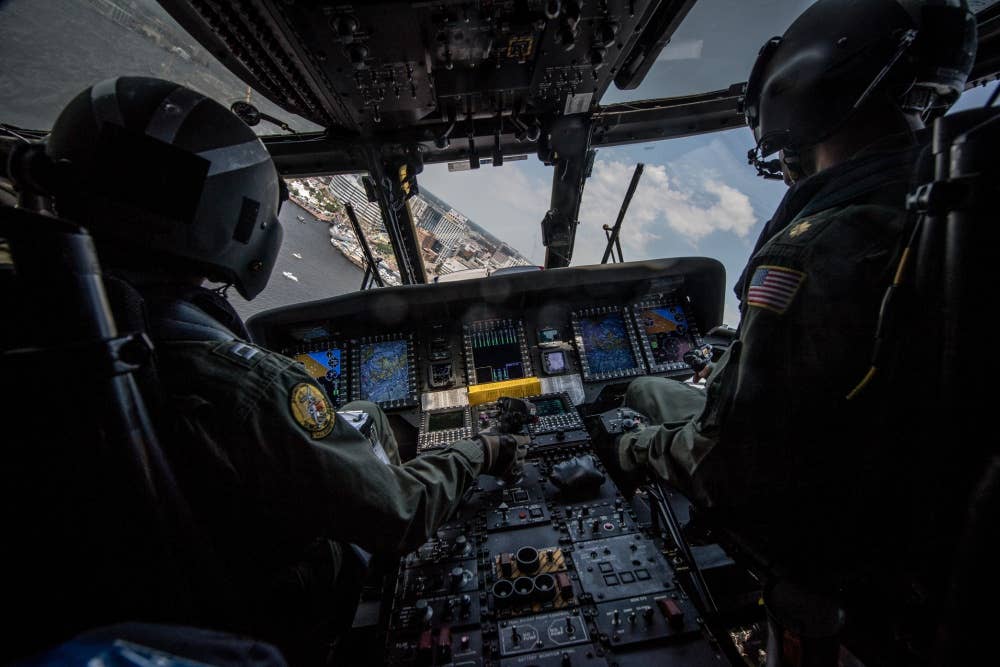
Coast Guard rotary aircraft often operate from Coast Guard or Navy ships. U.S. Coast Guard
U.S. Coast Guard Search and Rescue (SAR) pilots provide assistance to individuals in distress in maritime environments, and also perform drug interdiction and national security missions. The HH-65 Dolphin and MH-60 Jayhawk helicopters are the Coast Guard's primary Search and Rescue platforms; fixed-wing aircraft are also utilized. Lt. Cmdrs. Mike Baird and Ron Bledsoe, both Dolphin SAR pilots currently assigned to the Office of Aviation Forces at the U.S. Coast Guard headquarters in Washington, D.C., outlined the demanding path to becoming a Coast Guard Search and Rescue pilot. First, Baird says, "You have to earn your Coast Guard wings."
What does it take to become a Coast Guard aviator?
A bachelor’s degree and an officer’s commission are required to qualify for Coast Guard flight training. Baird and Bledsoe both attended the Coast Guard Academy for their degrees and commissions. Qualified enlisted personnel can receive commissions through Officer Candidate School. To boost chances for acceptance to flight school, “Work hard in jobs you’re in and get good evaluations,” Bledsoe says. Aviators from other military services may also become Coast Guard pilots through the Direct Commission Aviators (DCA) program, and pilots in the private sector apply for the flight program and attend OCS for their commissions.
Where do Coast Guard pilots receive primary training?
Pilots receive fixed-wing flight training at NAS Pensacola and NAS Corpus Christie, then undergo transition training to operate Coast Guard platforms. Helicopter pilots train at the Coast Guard Aviation Training Center in Mobile, Alabama.
How do Coast Guard pilots become SAR qualified?
Basic SAR Qualification — demonstrating planning, communications and procedural abilities — allows aviators to serve as SAR co-pilots, and can be earned in conjunction with ongoing training courses. Aircraft commanders must have an Advanced Search and Rescue Qualification — the ultimate SAR rating. Advanced Qualification requirements include completing a study syllabus, attending the Coast Guard’s National Search and Rescue School, passing an oral exam, and meeting pilot proficiency requirements.
What training is required to maintain SAR skills and qualifications?
Heavy training is required to maintain proficiency and currency. “We have to train in challenging environments,” Baird says, citing hovering at night and hoisting loads offshore as examples. Training at the Advanced Helicopter Rescue School in Cape Disappointment, Washington, is scheduled to coincide with the year’s worst weather. Survival and egress training are among the annual recurrency requirements.
How much do SAR pilots earn?
As with all military personnel, Coast Guard pilots’ pay is based on rank and service time, supplemented by Aviation Career Incentive Pay. Advanced SAR Qualified Aircraft Commanders typically earn between $90,000 and $120,000 annually, along with priceless benefits like “going out and finding the people you’re looking for,” Bledsoe says.
Post-service employment options
Coast Guard aviators have no mandatory retirement age, but opportunities in the private sector entice many to switch employers. SAR pilot skills are transferable to EMS and medevac piloting jobs, and military rotary ratings are in high demand in the oil and gas sectors. Moreover, Coast Guard pilots’ skills and training put them in high demand for flying virtually any platform for which they’re qualified. Some of Baird’s former rotary wing colleagues “are flying [Erickson] Skycranes in Oregon,” he says. Learn more about Search and Rescue pilots and other Coast Guard careers at uscg.mil/top/careers.asp.

Sign-up for newsletters & special offers!
Get the latest FLYING stories & special offers delivered directly to your inbox






